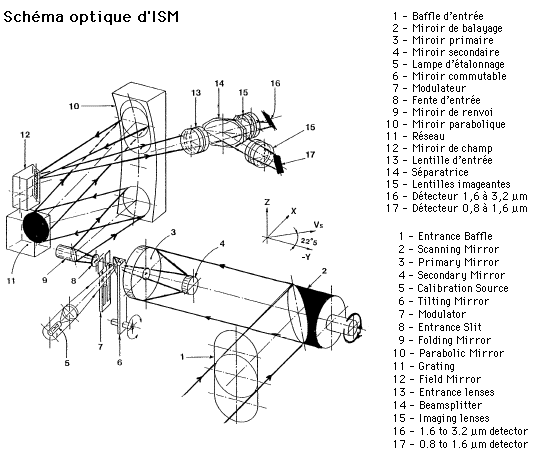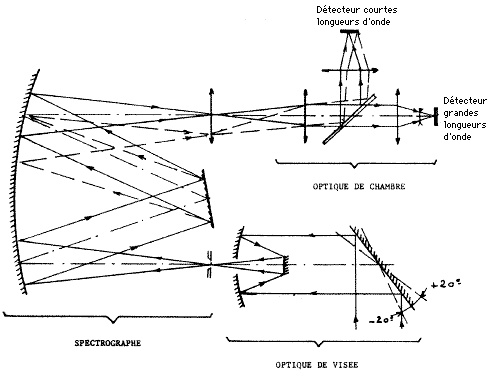Un instrument de seconde génération, OMEGA,
a ensuite été développé par les mêmes équipes (avec la participation supplémentaire de l'IFSI à Rome et de l'IKI à Moscou) pour la mission Mars-96, perdue au décollage le 17 novembre 1996. Le modèle de rechange d'OMEGA sera embarqué
sur la mission Mars-Express de l'ESA qui entrera en orbite martienne en janvier 2004. Les mêmes technologies ont été réutilisées pour VIMS
à bord de Cassini, et pour VIRTIS qui volera sur la mission Rosetta.
(Les images sont tirées des documentations techniques de l'instrument).
ISM was the first space-borne
imaging spectrometer to perform planetary observations. The instrument flew
on board the soviet Phobos-2 spacecraft launched on July 21st, 1988, and
remained in Martian orbit from January 29th to March 27th, 1989. It was
developed by IAS (CNRS-Université Paris-Sud) and DESPA (Observatoire
de Paris) and was supported by CNES (French space agency). The project manager
was Alain Soufflot, the Principal Investigator was Jean-Pierre Bibring,
both from IAS; the lead scientist at DESPA was Michel Combes.
Three models of the instrument were built. The one that flew on Phobos-2
was called MV1 (Modèle de Vol numéro 1). It returned ~35 000
spectra of Mars (~27 Mbytes of data), that still compose the only imaging spectroscopy
data set of Mars at high resolution. An image cube of 400 spectra of Phobos
was also acquired; these data provided the first spectra of Phobos
(with those of KRFM, the UV-vis spectrometer on board Phobos-2), and the
first observations in the infrared of Mars' largest satellite.
MV2 was launched on Phobos-1 that was lost during its voyage to Mars,
and hasn't returned any data. The spare model MV3 was modified by CESR in
1991 to fly on the ARAT airplane, a common facility to CNES and IGN, to
evaluate the scientific interest of terrestrial observations in this spectral
range.
A second generation instrument, OMEGA, was later developed by the same teams (with extra participation from IFSI in Rome and IKI in Moscow) for the Mars-96 mission, that was lost at launch on November 17th, 1996. The spare model of OMEGA will fly on ESA's Mars Express mission, which will orbit Mars in January 2004. Similar technologies have been used for VIMS on-board Cassini, and for VIRTIS which will fly on Rosetta.
(Images are adapted from the technical documents).

Vue éclatée de l'instrument / Optical
configuration
ISM utilise une méthode « whiskbroom »
: les pixels sont acquis l'un après l'autre ; le balayage en longitude
est effectué en tirant parti du mouvement orbital de la sonde ; l'autre
dimension spatiale est balayée grâce à un miroir mobile.
Le spectre complet du pixel observé est acquis en une seule fois,
de façon à ce que chaque spectre corresponde à une
petite zone de la dimension du champ de l'instrument (champ de vision instantané de
12'). Le temps d'intégration (0,5 s pour la plupart des modes) et
la longueur des balayages sont adaptés pour obtenir des pixels adjacents,
et donc reconstituer une image de la surface. Un gain électronique
variable permet de maintenir un niveau de sortie et un rapport signal sur
bruit acceptables quelle que soit l'intensité lumineuse détectée,
sans modifier le temps d'intégration.
La direction de pointage est normalement anti-solaire quand la sonde
est stabilisée (direction -X). Le mécanisme de balayage est
constitué d'un miroir mobile par pas de 12' en mode nominal ; ce
miroir tourne autour de l'axe optique de l'instrument (axe Y), et autorise
une excursion de ± 20° depuis la direction antisolaire le long
de l'axe Z. Ce mécanisme est utilisé pour le balayage spatial,
et pour la sélection des zones d'observation. L'altitude de l'orbite
de la sonde détermine la taille des pixels observés, 25 km
pour la plupart des observations de Mars (mode basse résolution).
Des observations à haute résolution (7 km) ont été
effectuées au début de la mission quand la sonde était
sur une orbite d'insertion à périastre bas. Les observations
de Phobos ont eu lieu pendant la phase d'approche du satellite (orbites
quasi-synchrones) à 700 m de résolution. Par comparaison,
les meilleures observations terrestres de Mars sont limitées à
une résolution de l'ordre de 150 km au centre du disque, pendant
une période limitée à quelques semaines autour de l'opposition
(tous les deux ans).
ISM uses a whiskbroom concept:
pixels are acquired in sequence; longitude scanning is obtained with the
motion of the spacecraft on its orbit; the other spatial dimension is scanned
by a one-axis mechanism. A complete spectrum is acquired at each time step,
so that every spectrum corresponds to a given spot on the surface of the
dimension of the IFOV (12'). Integration times and scan lengths are set
so as to obtain adjacent pixels, and thus to reconstitute continous images
of the surface. A variable analogic gain allows to get a correct output
signal and signal to noise ratio whatever the intensity measured, whitout
changing the integration time.
The viewing direction of the instrument is normally anti-solar when
the spacecraft is stabilized (-X direction). The scanning mechanism consists
of an entrance mirror moving around this rest position by steps of 12' in
nominal mode. The mirror turns around the Y-axis of the instrument (the
optical axis of the telescope) and allows an excursion of ±20°
from the anti-solar position along the Z-axis. Due to the altitude of the
spacecraft, the pixel size is about 25 km (medium-resolution) for most
observations of Mars. Higher resolution (~7 km) was achieved at the
beginning of the mission when the spacecraft was on a transfer orbit with
low pericenter. Phobos observations were performed at 700x700 m2
pixel size during the approach of the satellite (quasi-synchronous orbits).
For the sake of comparison, the best ground-based observations of Mars are
limited to about 150 km at the disk center, for a few weeks around opposition
(every other year).

Système optique / Principle
of the optical system
Le spectromètre couvre le domaine allant de 0,76 à
3,16 µm avec 128 canaux spectraux. Le système dispersif est
un réseau dont les deux premiers ordres sont utilisés pour
minimiser la taille de l'instrument, augmenter la luminosité et décroître
les aberrations. Ces deux domaines de longueur d'onde (de 1,64 à
3,16 µm dans l'ordre 1 et de de 0,76 à 1,51 µm dans l'ordre
2) sont séparés par une lame séparatrice et focalisés
sur deux matrices PbS indépendantes. Les matrices sont refroidies
passivement à -70°C. Chacune de ces matrices est
constituée de deux rangées de 32 détecteurs en quinconce,
regardant dans des directions séparées de 23' (environ deux
pixels). Ces deux sous-ensembles de canaux sont difficiles à coregistrer,
si bien que la plupart des analyses n'utilisent que le jeu de 64 mesures
qui possède le meilleur rapport signal sur bruit. L'échantillonnage
spectral résultant est de 25 nm dans l'ordre 2, et de 50 nm dans
l'ordre 1. Dans chaque intervalle, la résolution varie de 30 à
60.
Les étapes principales de l'étalonnage des données
sont les suivantes :
- Soustraction du courant d'obscurité, mesuré avant et
après chaque session.
- Registration des mesures spectrales dans chaque canal.
- Division par le gain utilisé.
- Correction de détectivité en fonction de la température.
- Soustraction des ordres parasites du réseau (contributions des
ordres 1 et 3 dans la voie petites longueurs d'onde).
- Division par un spectre solaire normalisé à la distance
Mars-Soleil au moment de l'observation.
- Étalonnage absolu, incluant la division par la réponse
des détecteurs et la soustraction de la lumière parasite
estimée.
L'étalonnage final des données est réalisé avec une précision relative de 0,3 à 0,5 % sur la plus grande partie du domaine spectral (précision des rapports canal à
canal). La documentation décrit en détails le fonctionnement de l'instrument, l'étalonnage des données et la précision des mesures.
The spectrometer spreads the spectral
range from 0.76 to 3.16 microns in 128 spectral channels. The dispersing
system is a grating, the first and second orders of which are used so as
to minimize the size of the instrument, increase the luminosity and decrease
optical aberrations. These two wavelength ranges (from 1.64 to 3.16 µm
in the first order and from 0.76 to 1.51 µm in the second order) are
separated by a beam-splitter and focused on two independent 64-elements
PbS arrays. The two arrays are passively cooled down to -70°C.
Each of these arrays is in turn made up of two staggered rows
of 32 detectors, that look in directions differing by ~23' (about two pixels
width). These two subsets of spectral channels are difficult to register,
so most research papers used only the subset with higher signal to noise
ratio. The resulting spectral step is 0.05 and 0.02 microns between contiguous
spectral channels in the long and short wavelengths range respectively.
In both ranges, the spectral resolution of the instrument thus varies from
30 to 60.
The successive steps in the calibration process
are:
- Subtraction of the dark currents measured before
and after each observation session.
- Correction for spectral misregistration.
- Division by the analogic gain selected for the
session.
- Correction for variations of detectivity with
temperature.
- Removal of spectral overlaps, ie. first and third
orders contributions in the short wavelengths range.
- Division by the solar spectrum scaled to the
Sun-Mars distance at the time of observation.
- Absolute calibration, including division by the
transfer coefficients and subtraction of an additional offset accounting
for stray light.
The final calibration yields
an accuracy of ~0.5-0.3% on normalized spectra (channel to channel ratios)
in most of the spectral domain. The documentation
describes in details the instrument functionning, the data calibration scheme and the final accuracy of the measurements.
| Telescope |
Ritchey-Chretien, 25 mm aperture, f/4 |
| FOV |
12' (3.6 mrad)
±20° scanning system in 2400 steps |
| Spectrometer |
Grating, first and second orders |
| Detectors |
2 arrays of 64 PbS detectors in staggered rows
-75°C operating temperature (passive cooling) |
| Electronics |
0.125 to 1 s integration time
1, 2, 3 or 6 analogic gain |
| Optical path |
Short-wavelengths |
Long-wavelengths |
| Spectral range |
0.76-1.51 µm (second grating order) |
1.64-3.16 µm (first grating order) |
| Spectral sampling |
12.5 nm |
25 nm |
| Bandwidth |
25 nm |
50 nm |
| Subsystem |
ISM1 (optics and processing) |
ISM2 (electronics) |
| Size |
274 x 271 x 212 mm |
184 x 180 x 108 mm |
| Weight |
~4 kg |
~2.1 kg |
| Power consumption |
14 W (1 W in stand-by mode) |
Caractéristiques de l'instrument
 ISM
a été développé avec le soutien du CNES
ISM
a été développé avec le soutien du CNES
Dernière mise à jour : 11 mai 2001
Adresse : http://www.ias.u-psud.fr/ism/
ISM
a été développé avec le soutien du CNES